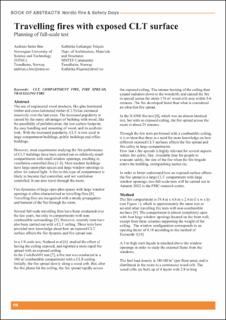| dc.description.abstract | The use of engineered wood products, like glue laminated timber and cross laminated timber (CLT) has increased massively over the last years. The increased popularity is caused by the many advantages of building with wood, like the possibility of prefabrication, the low carbon footprint, the easy handling and mounting of wood, and its aesthetic look. With the increased popularity, CLT is now used in large compartment buildings, public buildings and office buildings.
However, most experiments studying the fire performance of CLT buildings have been carried out on relatively small compartments with small window openings, resulting in ventilation controlled fires [1-3]. Most modern buildings have large open-plan spaces and large window openings to allow for natural light. A fire in this type of compartment is likely to become fuel controlled, and not ventilation controlled. It can also travel through the room.
Fire dynamics of large open-plan spaces with large window openings is often characterized as travelling fires [4]. Travelling fires are recognized with a steady propagation and burnout of the fire through the room.
Several full-scale travelling fires have been conducted over the last years, but only in compartments with non-combustible surroundings [5]. However, recently tests have also been carried out with a CLT ceiling. These tests have provided new knowledge about how an exposed CLT surface affects the fire dynamic and fire spread rate.
In a 1/8-scale test, Nothard et al.[6] studied the effect of having the ceiling exposed, and reported a more rapid fire spread with an exposed ceiling. In the CodeRed#01 test [7], a fire test was conducted in a 380 m2 combustible compartment with a CLT-ceiling. Initially, the fire spread slowly along a wood crib. But, after the fire plume hit the ceiling, the fire spread rapidly across
the exposed ceiling. The intense burning of the ceiling then caused radiation down to the woodcrib, and caused the fire to spread across the entire 174 m2 wood crib area within 5-6 minutes. The fire developed faster than what is considered an ultra-fast fire spread.
In the X-ONE fire test [8], which was an almost identical test, but with no exposed ceiling, the fire spread across the room in about 25 minutes.
Through the few tests performed with a combustible ceiling, it is evident that there is a need for more knowledge on how different exposed CLT surfaces affects the fire spread and fire safety in large compartments. How fast a fire spreads is highly relevant for several aspects within fire safety, like: Available time for people to evacuate safely, the size of the fire when the fire brigade enters the building, extinguishing tactics etc.
In order to better understand how an exposed surface affects the fire spread in a large CLT compartment with large window openings, two full-scale tests will be carried out in Autumn 2022 in the FRIC-research centre. | en_US |

